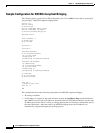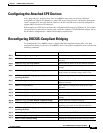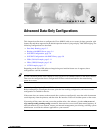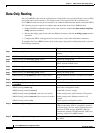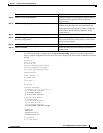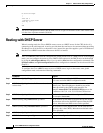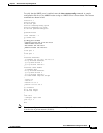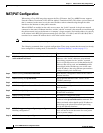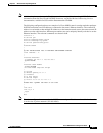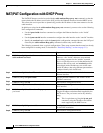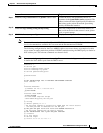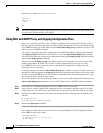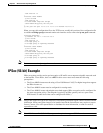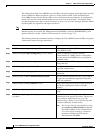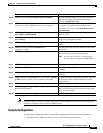
3-6
Cisco uBR924 Software Configuration Guide
OL-0337-05 (8/2002)
Chapter 3 Advanced Data-Only Configurations
NAT/PAT Configuration
NAT/PAT Configuration
When using a Cisco IOS image that supports the Easy IP feature, the Cisco uBR924 router supports
Network Address Translation (NAT) and Port Address Translation (PAT). This allows a private network
that is connected to the router to use the same IP address when communicating through the cable
interface to the Internet or other public networks.
When NAT/PAT are enabled on the cable access router, the “inside” network is the private network
connected to the router’s Ethernet interface, and the “outside” network is the network accessed through
the cable network (such as the Internet or a company’s larger network). Each inside address is typically
an IP address in the RFC1918 private network space (10.0.0.0, 172.16.0.0, and 192.168.100.0) and is
translated to an external IP address that is valid in the outside network.
Note NAT/PAT can be used only in routing mode.
The following commands show a typical configuration. (These steps assume that the router has already
been configured for routing mode, as described in “Data-Only Routing” section on page 3-2.)
Command Purpose
Step 1
uBR924(config)# ip nat inside source list list-id interface
cable-modem0 overload
Enable translation of the inside source
addresses—the “inside” addresses are translated
before being presented to the “outside” network.
The list-id specifies an access-list that defines the IP
addresses that will be used, and overload specifies
that multiple inside IP addresses can use the same
outside IP address (but using different port numbers
to unique identify each inside host).
Step 2
uBR924(config)# interface Ethernet0 Enter interface configuration mode for the router’s
Ethernet interface.
Step 3
uBR924(config-if)# ip nat inside Specify that the Ethernet is the “inside” of the
NAT/PAT translation.
Step 4
uBR924(config-if)# exit Exit interface configuration mode.
Step 5
uBR924(config)# interface cable-modem0 Enter interface configuration mode for the router’s
cable interface.
Step 6
uBR924(config-if)# ip nat outside Specify that the cable interface is the “outside” of
the NAT/PAT translation.
Step 7
uBR924(config-if)# exit Exit interface configuration mode.
Step 8
uBR924(config)# access-list list-id permit address mask Creates the access list specified by the list-id
parameter in the ip nat inside source command. The
address and mask values should specify IP addresses
that belong to the private IP network space being
used by the Ethernet interface.
Step 9
uBR924# copy running-config startup-config
Building configuration...
Save the configuration to nonvolatile memory so
that it will not be lost in the event of a reset, power
cycle, or power outage.
Step 10
uBR924# show startup-config Display the configuration file that was just created.



